Decoding Image Labeling, The Backbone of Your ML Project
Image labeling is the process of categorizing entire images and their components or identifying specific objects within them. This process applies to various types of visual data, including static pictures, videos, 3D models, or projections, and plays a crucial role in image recognition and all supervised machine learning (ML) projects involving visual data. To comprehend and interpret visible information accurately, an ML model must be trained on a substantial volume of prelabeled data.
In this article, we will delve into the details of image labeling, exploring its significance, use cases, methodologies, and challenges. Whether you're an experienced computer engineer or a curious newcomer from any business domain, understanding this essential stage of an ML project is paramount.
What Is Image Labeling?
At its core, image labeling involves assigning meaningful tags to various elements within a digital image. Its goal is to provide a training dataset to teach an ML algorithm to recognize certain objects or features in a picture. These tags or labels provide context and meaning to the visual data, enabling the model to perform image classification and recognition tasks and, at least to some extent, assess relationships between different elements in an image.
In supervised ML, a model is trained on labeled datasets, meaning each input data point is paired with a corresponding target label or output. During training, the algorithm learns to map input data to the correct output by adjusting its internal parameters to minimize the difference between its predictions and the actual labels. Once trained, the model can generalize its knowledge and predict new, unseen data points based on the patterns it learned. This process lays the foundation for automated image recognition.
The term image labeling usually encompasses straightforward tagging of an unlabeled data piece and is referred to as a part of a broader concept of image annotation. A typical labeling task would be assessing a set of pictures to define if they contain a cat, a child, a bridge or even a comma and assigning a ‘yes’ or ‘no’ tag to each of them.
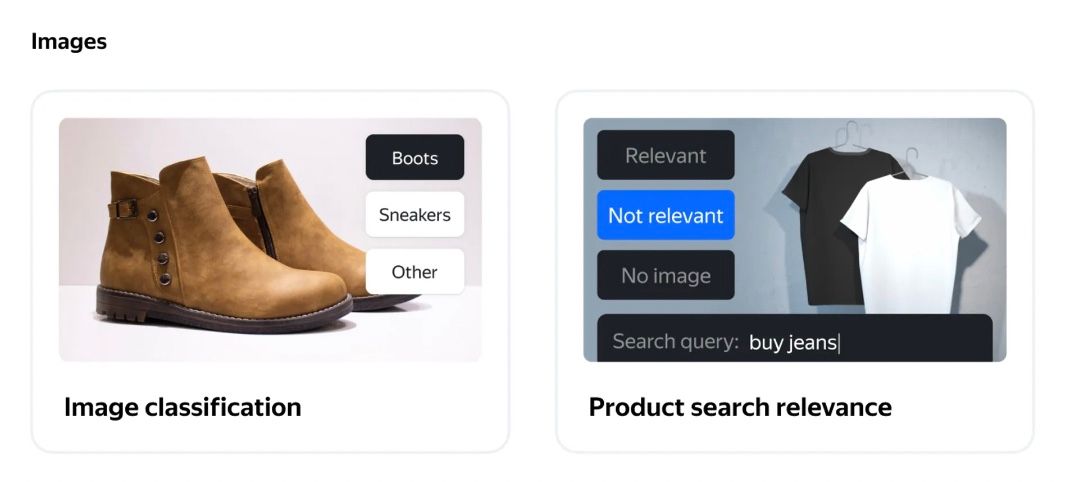
Initial labeling can involve tagging images as relevant or not, containing or missing a particular object, or identifying a type of object depicted. (Source: Toloka.ai)
A straightforward example of this image recognition ultimate use is seen in an autonomous vehicle navigating through a cityscape. Preliminary image labeling allows the computer vision system to identify pedestrians, traffic signs, and other vehicles. Through further image annotation, it enables the prediction of their interactions and facilitates informed decision-making regarding the vehicle’s movements and turns.
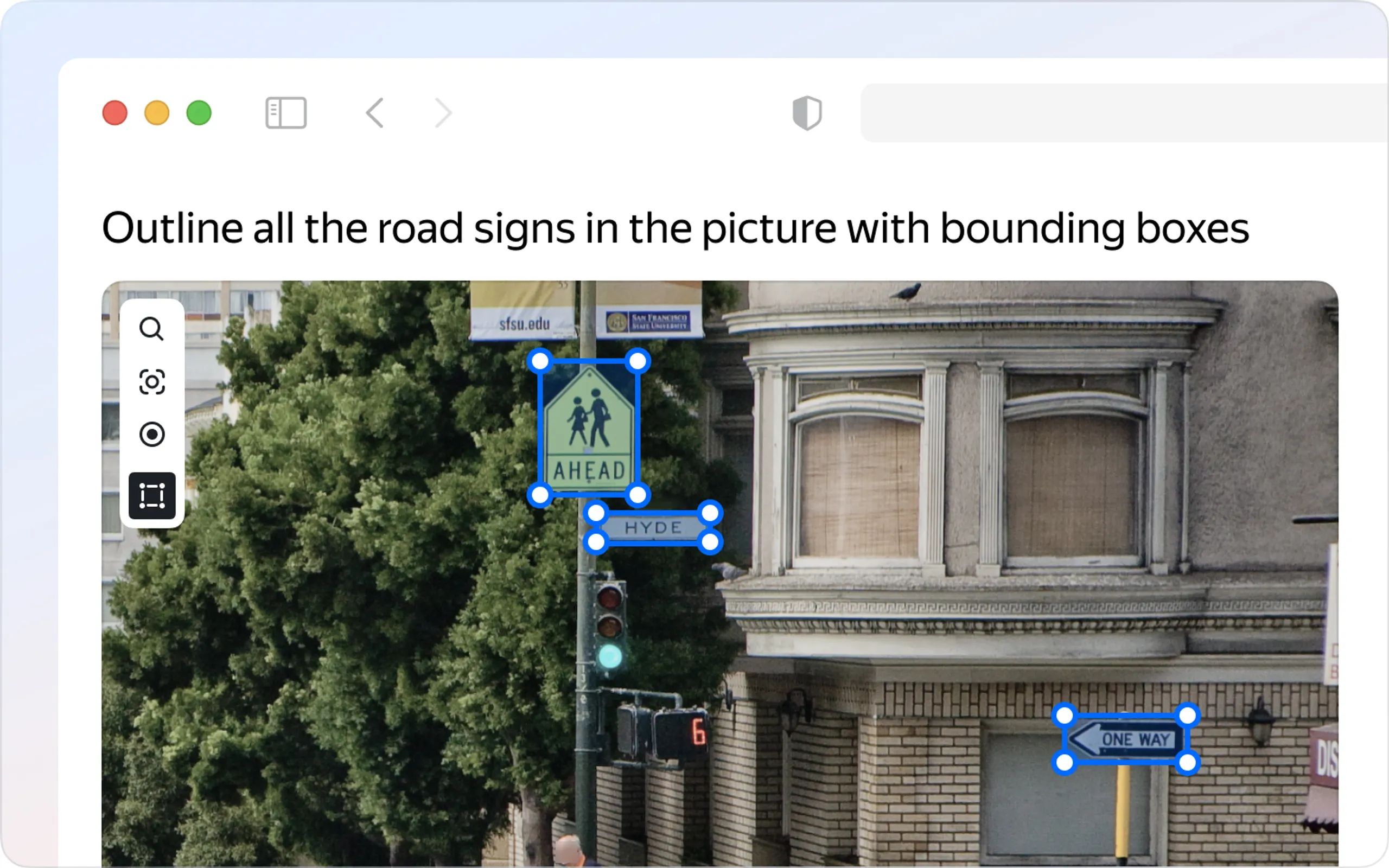
Besides straightforward image classification and object detection, other types of data annotation may include drawing bounding boxes and polygons to define object boundaries. (Source: Toloka.ai)
How Does It Work?
Image labeling aims to tag and identify specific elements within an image. This process encompasses adding descriptive tags to various types of raw data, such as digital images and videos, with each tag representing a distinct object class within the training data.
Supervised learning leverages these labeled datasets to train models to perform object recognition within unlabeled data. Through this process, labels provide a supervised machine-learning model with the necessary context to identify objects.
Data scientists and machine learning engineers utilize preliminary labeled datasets to both train and evaluate ML models. Ultimately, this enables the model to do the image recognition work without constant human input and autonomously assign new labels to unlabeled data.
Deep Learning Image Recognition
Deep learning suggests an alternative image recognition method by utilizing artificial neural networks. Inspired by the structure and function of the human brain, the latter understand and model complex patterns in unlabeled data.
A deep learning image recognition algorithm can automatically discover hierarchical representations of the input data, enabling it to extract features and patterns at multiple levels of abstraction.
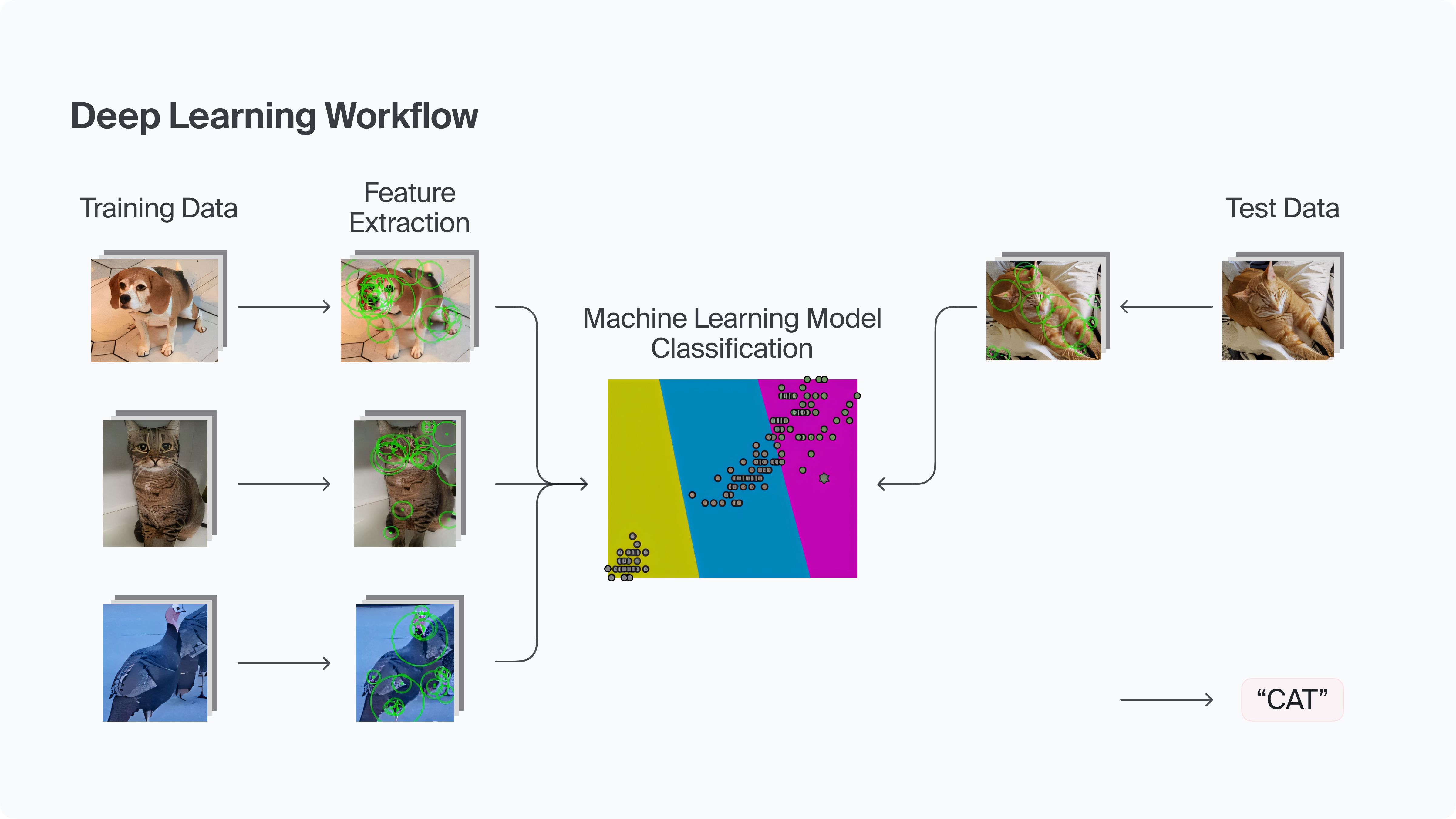
Deep learning workflow. (Source: Mathworks)
Large language models (LLMs) are DL algorithms that can recognize, summarize, translate, predict, and generate content using immense datasets. They serve as the foundation for automated data labeling tools that we'll discuss along with other methods.
Why Is Image Labeling So Important?
Image labeling is a crucial stage in the development of any computer vision application. Visual data annotation lays the groundwork for training machine learning models, providing the essential context for image recognition and subsequent distinguishing real-life objects and understanding their characteristics and interconnections.
The exclusive significance of image labeling for image recognition technology makes its quality critically important for an ML application project. None of the existing computer vision systems could function without a sufficient quantity of visual data collected and labeled at the initial stage of its development.
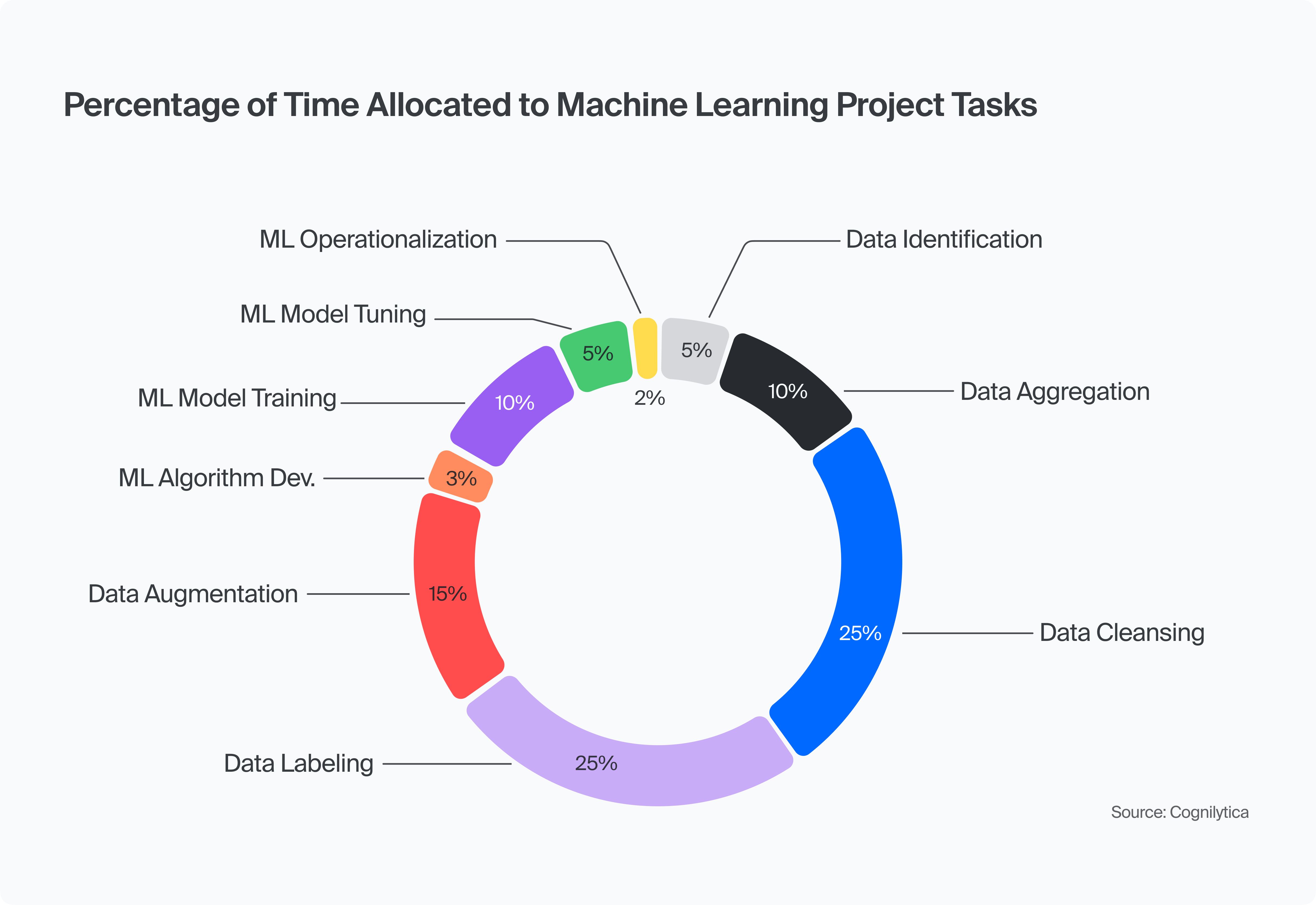
Usually, data labeling takes 25% of the entire time and budget of an ML project. (Source: Cognilytica)
What Does Image Labeling Do?
Helps algorithm training
Properly labeled images serve as the only base for a machine to identify specific features and objects by distinguishing similar elements and patterns. Thus, a dataset of digital images with meaningful tags lays the foundation for image recognition.
Enables ML models to interpret images
Thus, ML-based computer vision systems can outline individual objects in a picture. This image recognition technology gives way to analyzing their ratio and relations to predict their subsequent interaction. In certain cases, the identification of an object's presence has a significant value even without further automated analytics.
Enables computer systems to understand the real-world environment
Moving from interpreting a sufficient number of static or dynamic visuals is the only way for a computer to assess a real-world situation. Image recognition and swift analysis of individual object correlations enable the system to identify the safest decision to alert the user about risks. This cannot be achieved unless the ML model can instantly define meaningful object types around.
Image labeling is vital for training ML models to perform image recognition tasks, as the annotated data it provides serves as the foundation for learning algorithms. Accurate labeling enhances computer vision systems' reliability, enabling more precise classification and predictions. Without proper labeling, ML models will fail to generalize across diverse datasets, leading to questionable outcomes.
Image Labeling Use Cases
Any computer vision app's accuracy is dependent on the initial labeling and annotation. Properly tagged images are the core of ML model image recognition training. Data labeling, particularly for images, is faster and easier to scale than other annotation methods and is sufficient for many ML projects. However, this approach requires a precise understanding of what data you need to extract.
To identify image labeling use cases, one may ask, 'What is image recognition used for?' The answer will include, though not be limited to, the following categories.
Healthcare: Medical Imaging Analytics
Initial image labeling speeds up medical image analysis, including that for X-rays, CT scans, and MRIs, allowing ML-based apps to detect abnormalities. A single label assigned to an image can be a simple category, such as normal/abnormal. However, it can also presume foreign object detection or contain more precise information, such as tumor size or location.
ML-propelled software does not claim to replace doctors or other healthcare professionals but automated image recognition assists them in identifying unusual state of organs that may need further examination.
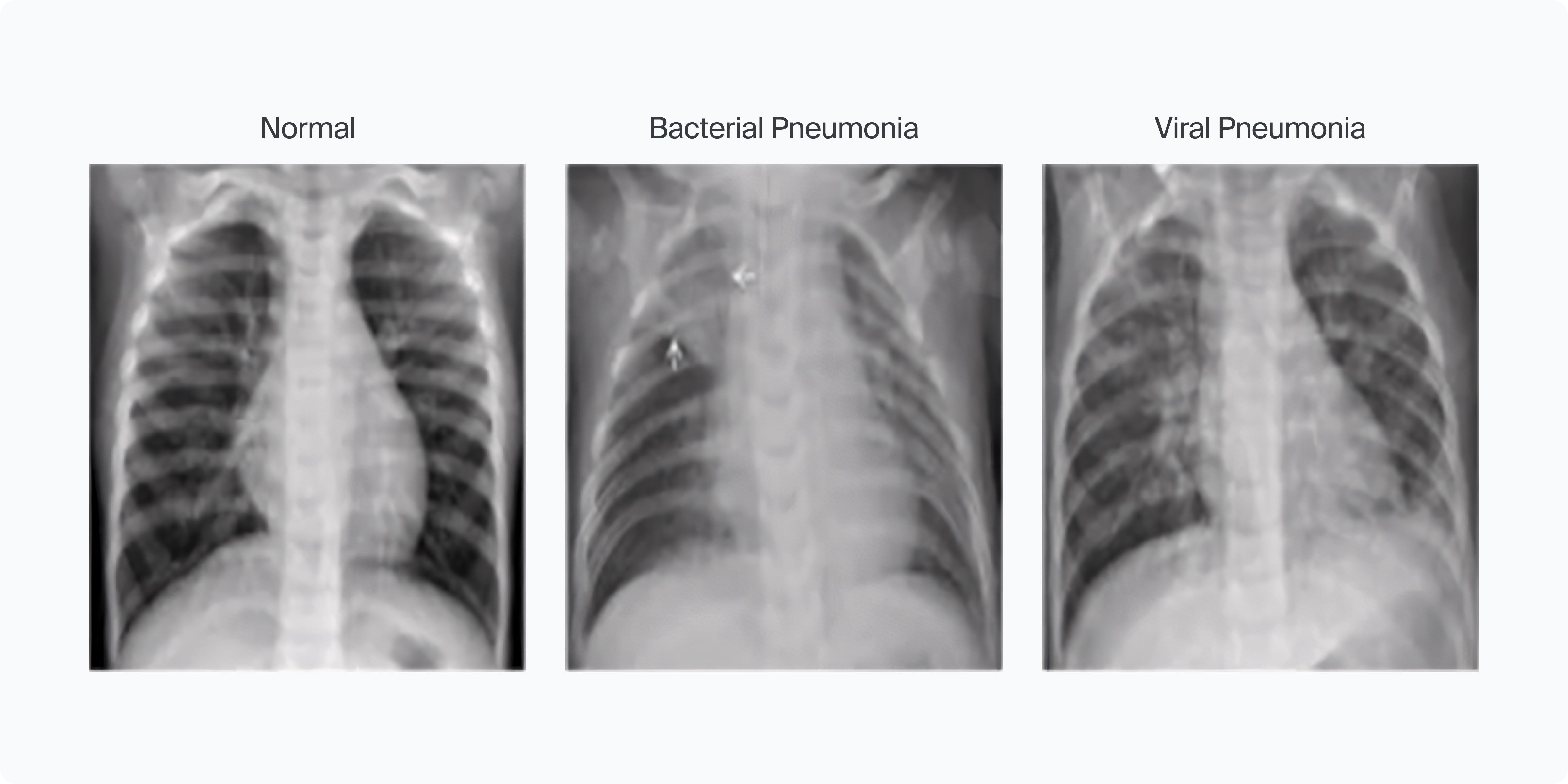
Sufficient volume of properly labeled data enables machine learning models to assume a diagnosis chosen out of a limited number of variants. For instance, an algorithm can distinguish bacterial and viral pneumonia with high accuracy. (Source: Journal of Big Data)
Medical images vary significantly depending on the source and technology used for their generation. It means image recognition tasks in healthcare may require various engineering solutions. Nevertheless, visual materials used by physicians exhibit distinct characteristics that set them apart from digital images in other domains. These images are particularly characterized by their multiple layers, larger size, and higher resolution, which are essential for capturing detailed anatomical information.
Additionally, healthcare data, including images, is subject to specific and much stricter regulatory standards and privacy considerations.
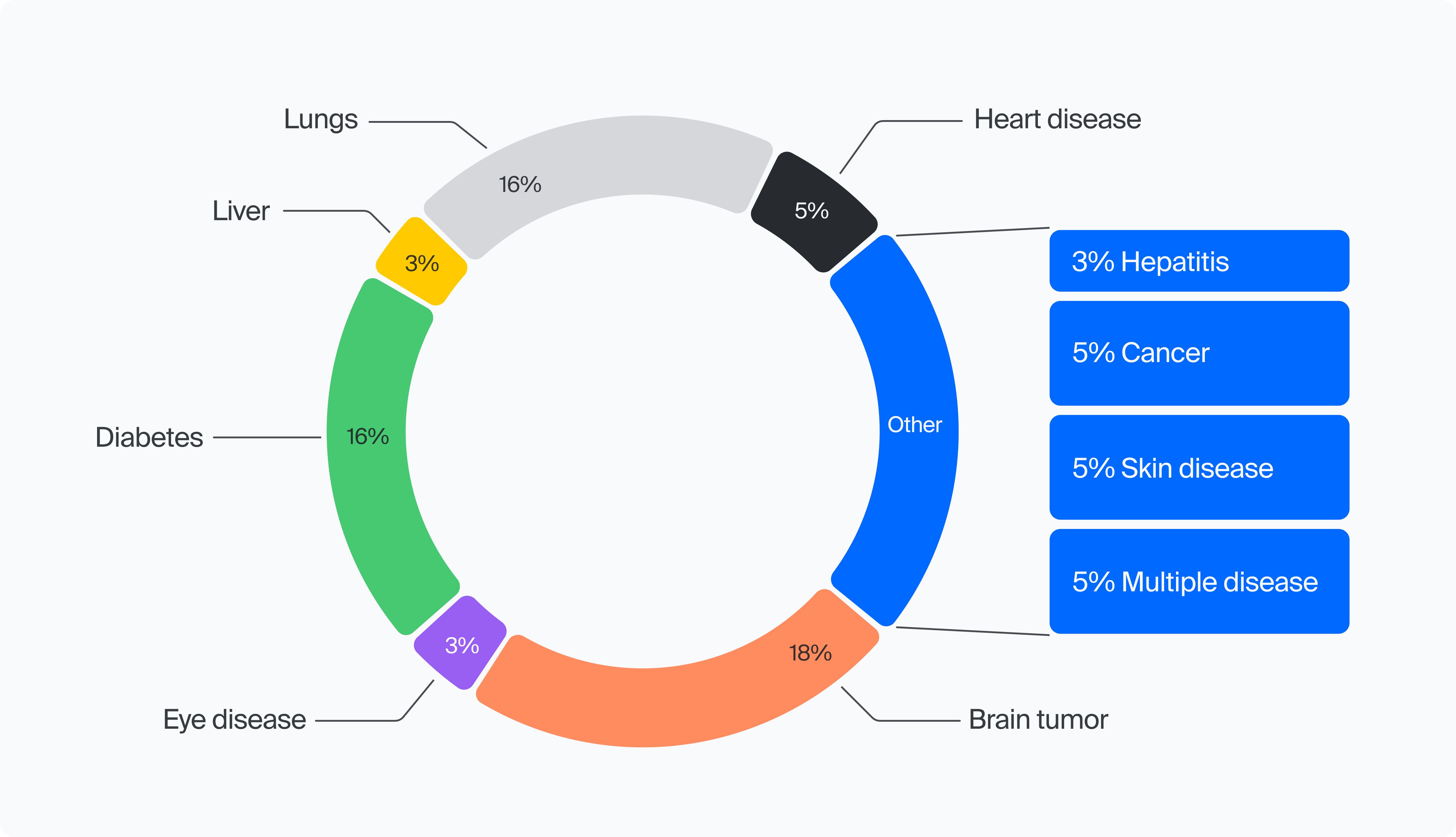
The percentage of multiple diseases diagnosed in the primary studies with the help of ML algorithms. (Source: Multimed Tools Appl)
Another notable challenge in medical image labeling is the necessity for domain expertise among data labelers. While basic online training may be sufficient for tagging images and performing more complex annotations in many spheres, the qualifications of a radiologist or radiographer are typically required for accurate medical image labeling.
E-Commerce and Traditional Retail
Machine learning models can significantly impact business operations for both e-commerce platforms and offline supermarkets and shopping malls. ML-based image recognition projects enable automation of product categorization, enhancement of search functionality, and delivery of personalized recommendations to customers based on their preferences. Additionally, they aid in monitoring store shelves and optimizing inventory management for better supply chain efficiency.
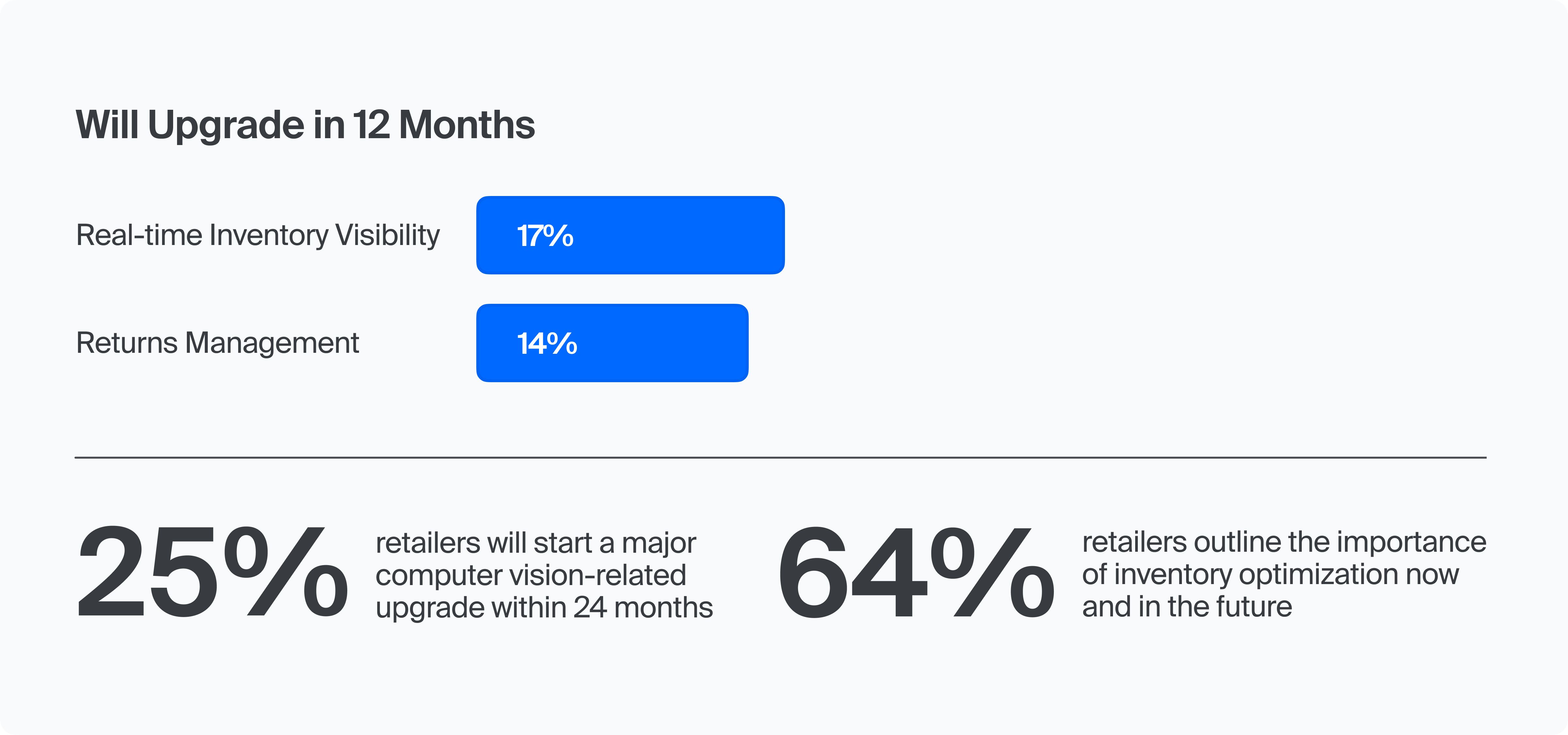
Inventory optimization and computer vision-based automation were in focus for major retailers already in 2020, according to the study by Retail Info Systems. (Source: Risnews.com)
All computer vision projects and image recognition software rely on prelabeled image datasets. In the retail industry, processing substantial amounts of tagged images is essential for training ML models to distinguish between specific goods and identify empty shelves. Moreover, image labeling can teach algorithms to recognize various barcodes simultaneously, streamlining retail operations without the need to read them individually.
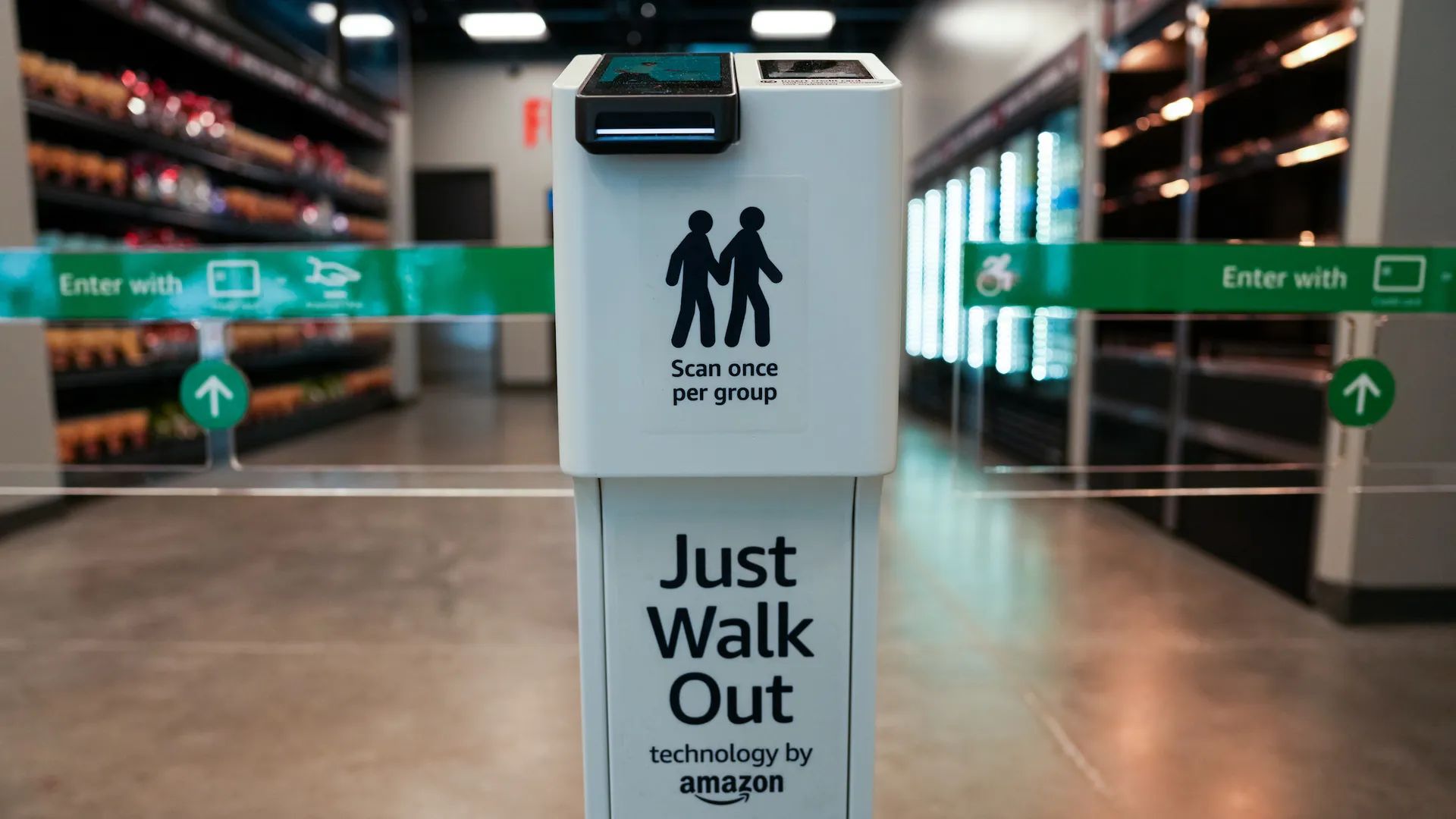
Computer vision-based object recognition is one of the core technologies behind the operation of fully automated Amazon Go supermarkets. To distinguish different goods in real-time image recognition models need to process thousands of their labeled pictures. (Source: About Amazon)
Security and Surveillance
ML empowers security applications to identify suspicious objects, individuals, or activities across surveillance footage, sensor readings, and network logs. Unlike humans, who may lose focus over time, computer image recognition systems maintain stable attention 24/7, continuously monitoring assigned areas. However, algorithms responsible for threat detection require pre-labeled datasets for training.
Beyond the instant detection of physical objects in surveillance footage, image recognition plays a crucial role in detecting digital network threats. Cybersecurity computer vision projects involve visualizing the binary content of files for analysis by ML algorithms.
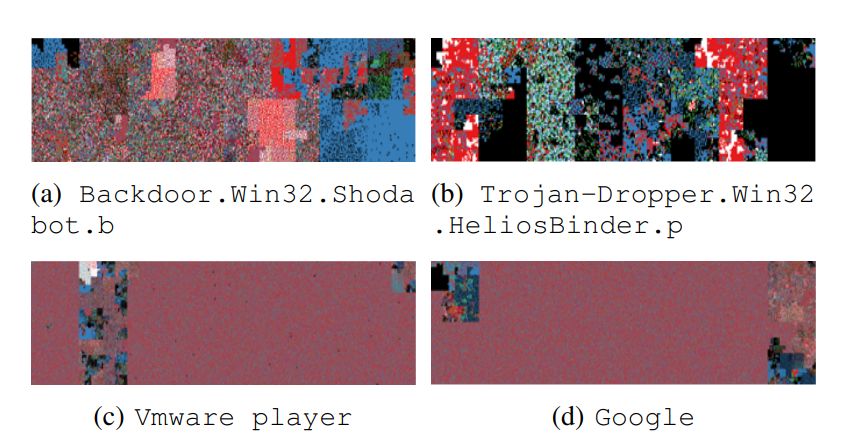
Binary visual comparison of malicious files (a) and (b) against normal files (c) and (d). (Source: IEEE ICC)
In the security domain, the training of a machine learning model involves labeling a digital image as either normal or abnormal, indicating the presence of possible threats.
Autonomous Driving
Automated driving systems require powerful object detection tools to adapt their operation to the surrounding environment. A self-driving car must not only adjust its speed for pedestrians and respond to traffic lights but also open the lane to emergency vehicles, consider warning signs, and differentiate between a truck and a motorcycle. Before going out in the streets, such systems must achieve image recognition ability comparable to that of a human driver.
That's why self-driving cars are typically equipped with high-resolution cameras, sensors, radars, and lidar scanners. However, the fundamental mechanism enabling software to classify objects on and around its route is based on thousands of prelabeled images captured by surveillance cameras.

A snapshot of several images from the BDD100K dataset commonly used for object detection and classification in autonomous driving. (Source: World Electric Veh. J.)
Datasets used to train ML models for autonomous vehicles can contain different numbers of classes, but they need to contain images depicting various sceneries, climate zones, weather conditions, and lighting. BDD100K, the largest driving dataset, has 100 thousand videos with up to 90 objects per image. It also contains rich annotations, including semantic segmentation. However, object detection is only possible by labeling training data with the classes of objects they contain.
Sports Analytics
Analytical software for sports usually requires complex data annotation to deliver detailed insights into an athlete's individual performance or team cooperation and tactics. However, sports are also full of binary outcomes: coaches, referees, and fans often need immediate information on goals scored or fouls committed. Player identification is equally vital for sports-related systems, whether for a team's internal analytical department or a TV broadcaster, and appropriate image retrieval for comparison may be challenging for different reasons.
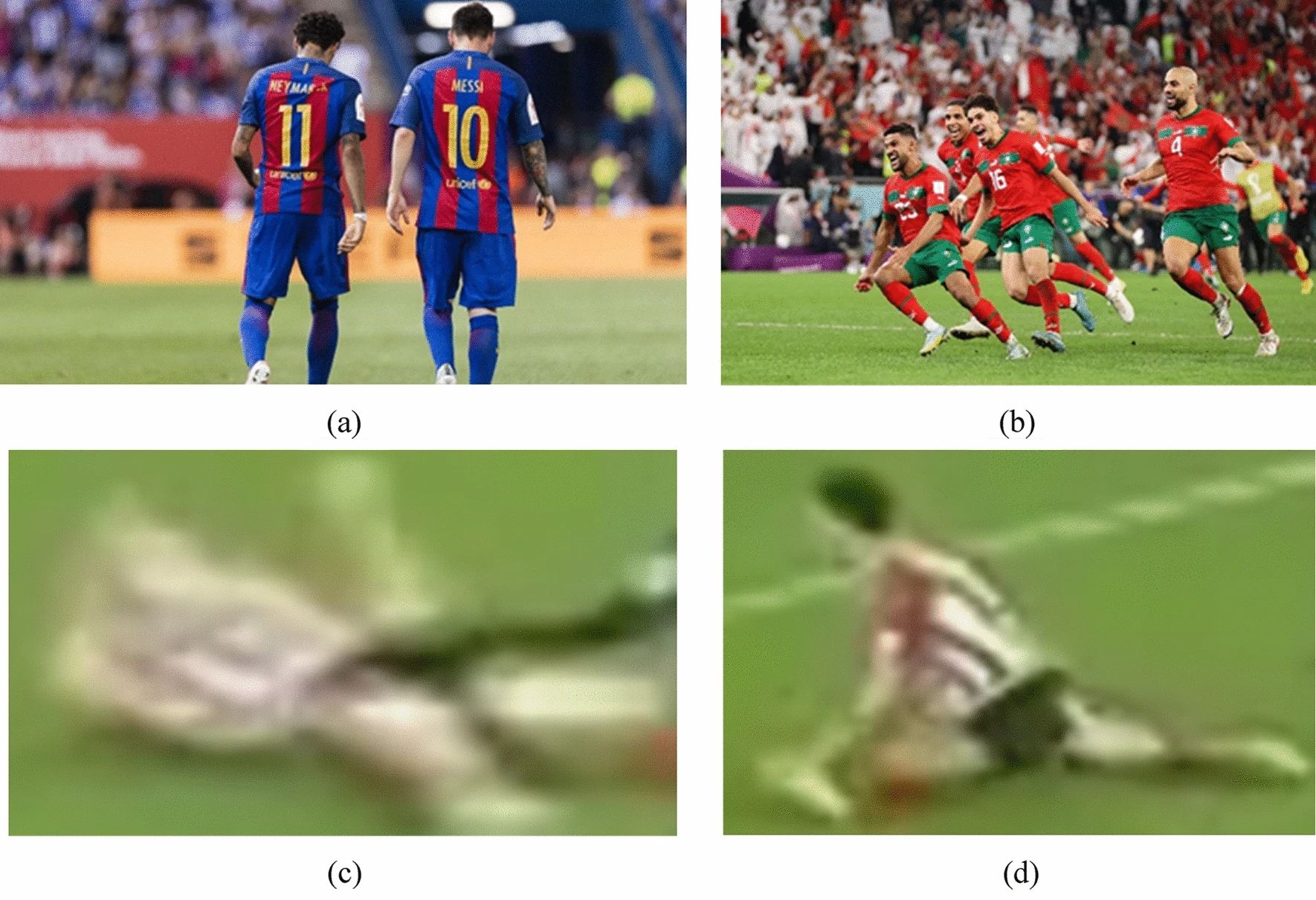
Identifying a football player in an image may be challenging due to similar uniform, occlusion, low resolution and various body positioning and movements. (Source: Nature.com)
Image labeling remains the most straightforward method of teaching an ML model to recognize particular teams, athletes, equipment items, and situations. And reliable image recognition technology is the backbone of any analytical tool in the sports domain.
Agriculture
Image recognition plays a crucial role in crop monitoring, disease detection, and yield prediction in agriculture. ML-based technology empowers farmers to make data-driven decisions to optimize their practices, and it needs thousands of labeled images for training.
Labelers can tag ripe fruit and crops to enable computer systems to determine optimal harvest times or assist agricultural robots in timely production picking. Additionally, they can label a digital image containing signs of particular crop diseases to alert farmers of potential threats.
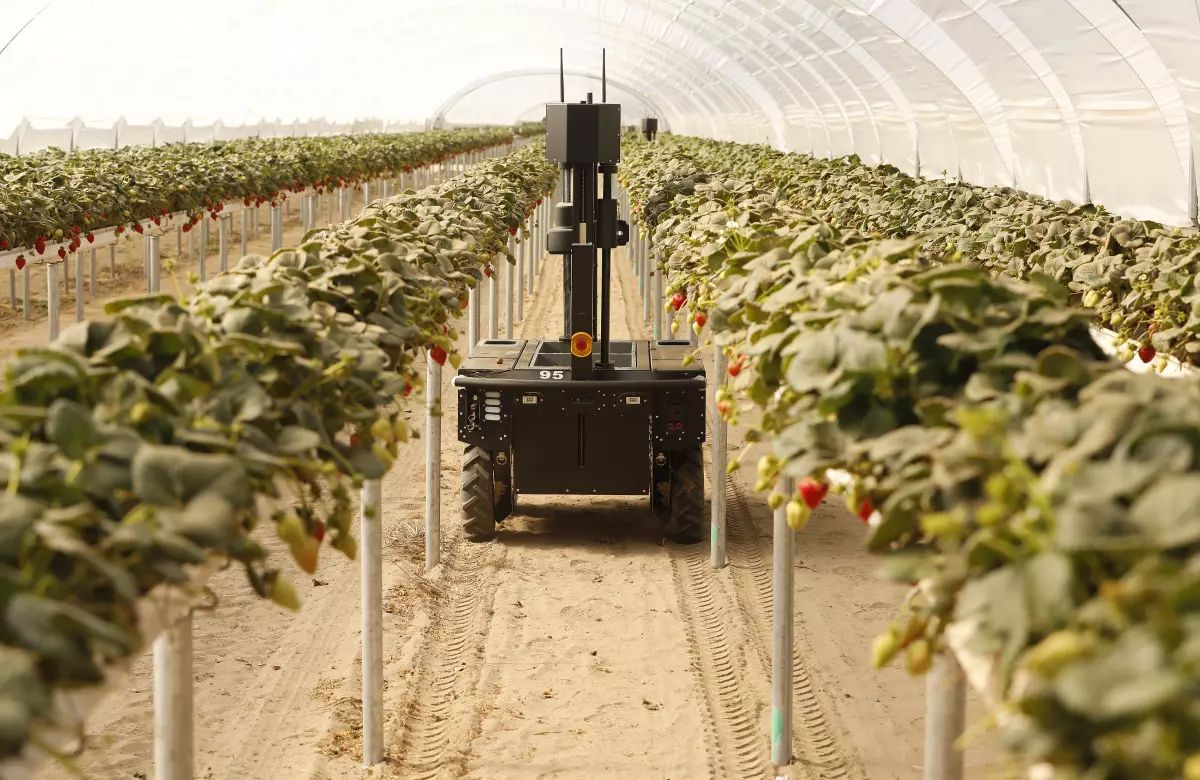
A Tortuga AgTech robot makes its way between rows of plants on hydroponic tabletops in Santa Maria, Calif. Image recognition allows it to choose and pick ripe strawberries. (Al Seib / For The Times; Source: LA Times)
Manufacturing
In industrial manufacturing, labeling images is essential for developing defect detection systems. ML models can learn to recognize quality problems and identify items requiring further inspection through tagged pictures or video fragments. Moreover, image recognition enables these models to classify the types of defects, enabling analytics and production process improvements.
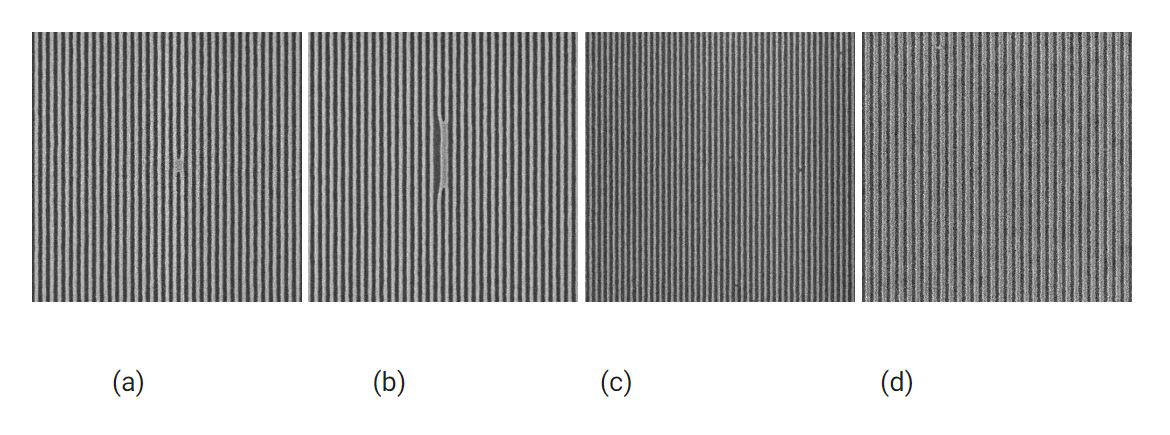
Classes of defects in semiconductor manufacturing. (Source: LearnOpenCV)
Another example of labeled data-based machine learning solutions in manufacturing is personal safety equipment detection systems. In essence, such image recognition tools alert authorized supervisors about employees entering specific zones without wearing required safety gear, such as helmets or protective suits.
Insurance
The insurance sector stands to gain significant benefits from computer vision services, which can accelerate processes and enhance customer experience. ML models for damage evaluation systems may require a more elaborate data annotation process than simple image labeling due to the complexity of the task.
However, image recognition techniques applied to insurance claims can facilitate potential fraud detection and even predict claim denials.
Methods of Image Labeling
High-quality datasets for supervised and semi-supervised machine learning can be expensive and time-consuming to obtain due to the labor-intensive nature of data labeling. While some organizations, including governmental bodies and research institutions, offer open datasets under various licenses, these may not be enough for specific projects requiring classifying and annotating proprietary file collections.
Data annotation, including image labeling, can be performed internally or outsourced. While certain automation tools are available to simplify the process, they have limitations that compromise data labeling quality.
Data labeling sets standards for image recognition algorithms, meaning labeling errors can affect the computer vision system's accuracy. Therefore, ensuring precise image labeling is crucial for effective ML model training.
Manual Image Labeling
This widely used method involves human annotators manually assigning meaningful tags to images based on predefined criteria. The mandatory human participation ensures relative accuracy and consistency throughout the process. However, manual labeling is labor-intensive and time-consuming, particularly for large datasets.
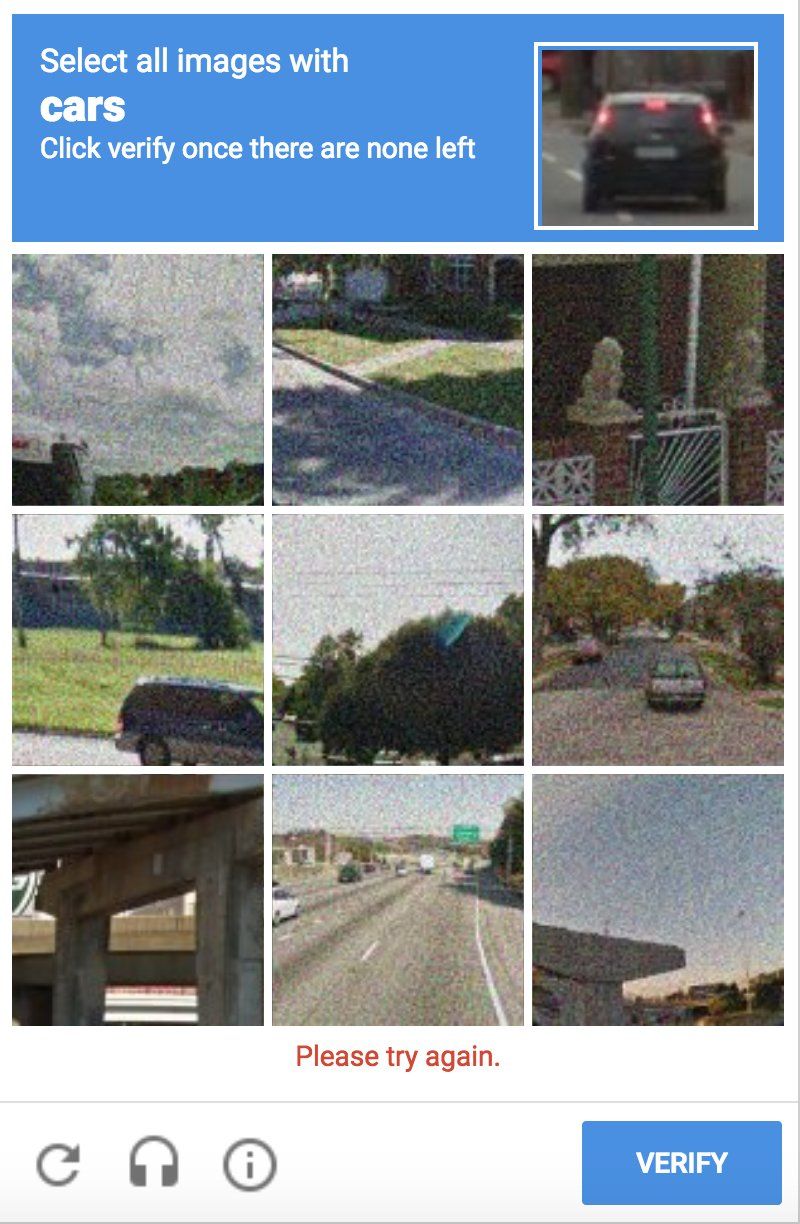
Google used its reCAPTCHA bot protection service to label images for building ML training datasets
Manual annotation typically relies on tools that assist operators in reviewing numerous images, assigning labels, drawing boundaries when needed, and storing data in a standardized format. The latter is important to facilitate its extraction for model training purposes.
Manual Image Labeling Challenges
Inconsistencies may arise when various annotators are involved. It forces multiple labeling passes or makes the project employ a majority vote approach.
Manual image labeling requires careful training of annotators and numerous iterations. It can potentially affect the time-to-market for computer vision projects.
The process of manual image labeling is costly and may be challenging to scale for large datasets.
Image labeling for particular domains may require domain expertise from every specialist involved. Hiring a whole team of labelers with specific knowledge and qualifications may be challenging for a project. One should also consider that experts may not be too interested in joining a project for a short period of time.
Automatic Image Labeling
Automatic labeling leverages algorithms to generate and assign tags to images using techniques like object detection, semantic segmentation, and pattern recognition. While it significantly reduces workload and speeds up the labeling process compared to manual methods, automatic labeling is not suitable for all tasks and industries. At least they may require validation to ensure quality and accuracy.
Large language models (LLMs)—advanced deep learning algorithms—have transformed the landscape of data labeling by leveraging vast training datasets. They use sophisticated methodologies to comprehend and interpret different kinds of content. However, they primarily excel in interpreting the text and may be less effective for image recognition tasks.
Automatic algorithms alone cannot fulfill the entire labeling task without human input. Humans are essential for developing these algorithms, collecting data, defining meaningful labels, and performing quality assurance checks to ensure the performance of these automated systems.
Automated Image Labeling Challenges
It can never provide 100% correct results, which makes it hardly suitable for collecting ground truth data for image recognition. An advanced automated labeling tool can move closer to the ideal outcome but never reach it, requiring constant human supervision.
In some edge cases, an automated system can get stuck, unable to assign any label to a particular image without human assistance.
Contrary to expectations, automated labeling outcomes are less predictable. In some cases, low-quality results, particularly edge cases, can increase the time required to complete the entire project.
Automated labeling results can be regarded as unreliable or doubtful in many domains where object recognition is critically important. This can harm a project’s relations with partners, investors, and regulators.
Hybrid Image Labeling
Hybrid labeling pipelines presume the use of large language models alongside human annotators to optimize costs while maintaining or even enhancing quality standards compared to manual labeling. However, achieving the perfect balance between LLM and human labeling requires fine-tuning based on extensive previous experience.
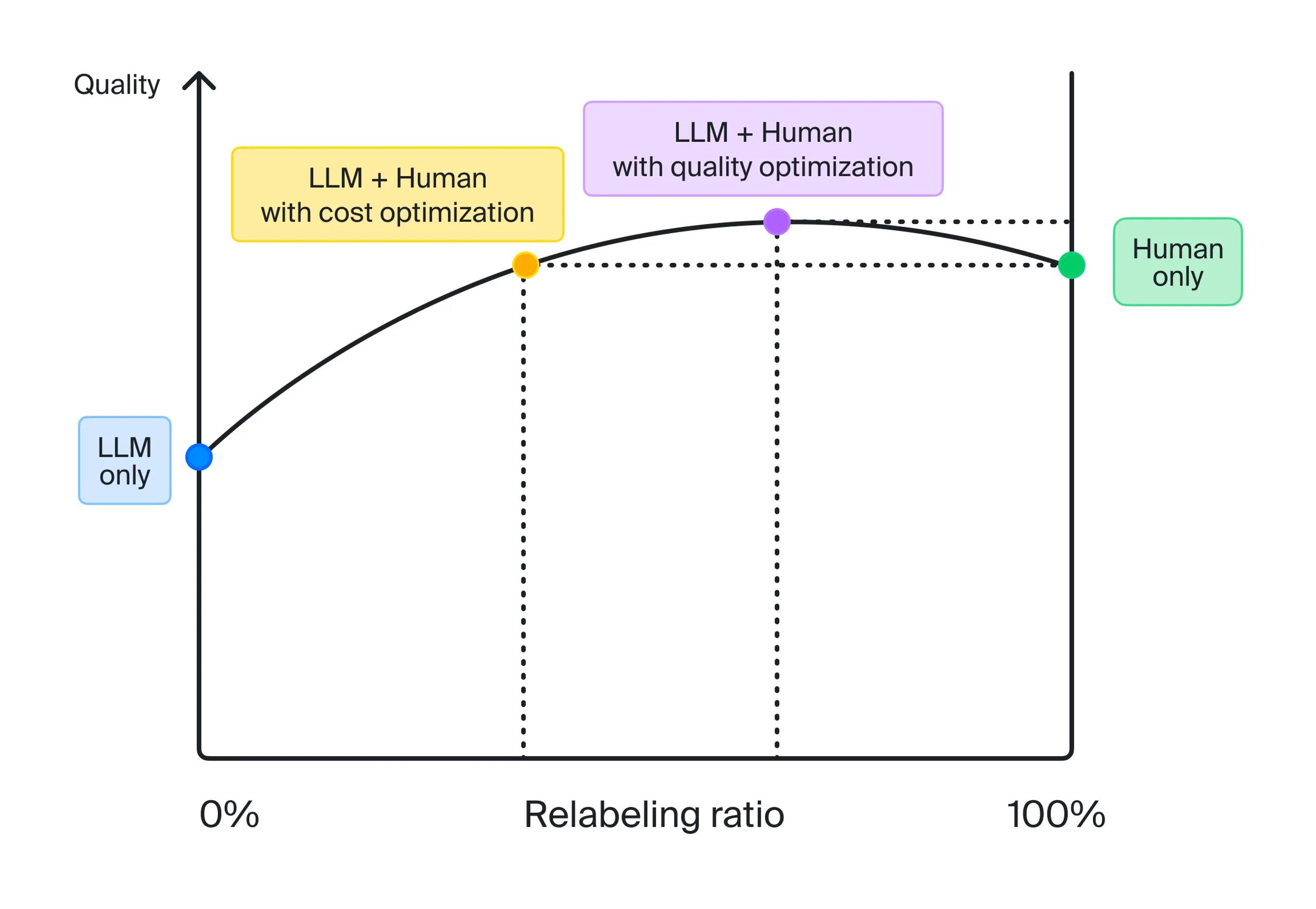
Quality vs relabeling ratio. Image by Sergei Tilga, R&D, Toloka. (Source: Toloka.ai)
The primary advantage of hybrid labeling is the ability to assign regular labels to images along with image recognition confidence levels, allowing images with low confidence levels to be sent to human annotators for relabeling. These pipelines offer flexibility, as they can be adjusted based on project needs, whether prioritizing cost efficiency or quality.
Perfect balance between LLM and human labeling allows hybrid pipelines to produce reliable labeling of exceptional quality. However, it requires specific expertise that can be hardly achieved by any internal team without a focus on this knowledge area.
Advancements and Challenges
Recent advancements in image labeling have been propelled by developments in deep learning, particularly convolutional neural networks (CNNs). CNNs excel in object detection and image segmentation, driving improvements in the overall accuracy of image labeling systems.
However, ML projects still face many challenges in image labeling, including the need for large annotated datasets or ensuring robustness to variations in lighting, perspective, and occlusion. As ML models become more complex, the demand for scalable and efficient labeling pipelines keeps growing subsequently.
Final Thoughts
Image labeling serves as the foundation for any machine learning project dealing with visual information. Labeled datasets are essential as they enable machines to comprehend and interpret images, whether static or dynamic.
By assigning meaningful labels to images, machine learning systems can navigate complex environments, make informed decisions, and drive innovation across diverse domains.
As technology continues to evolve, image labeling will remain a critical component in advancing the capabilities of machine learning and shaping the future of artificial intelligence.
Learn more about Toloka Hybrid Labeling pipelines:






